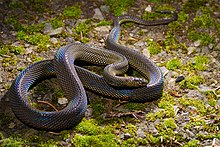Xenodermidae: Difference between revisions
Appearance
Content deleted Content added
authorities |
Xenodermidae |
||
| Line 4: | Line 4: | ||
| taxon = Xenodermatidae |
| taxon = Xenodermatidae |
||
| authority = [[John Edward Gray|Gray]], 1849 |
| authority = [[John Edward Gray|Gray]], 1849 |
||
| synonyms = Xenodermatinae <small>Gray, 1849</small> |
| synonyms = Xenodermatinae <small>Gray, 1849</small><br /> |
||
Xenodermidae <small>Gray, 1849</small><ref name="Snakes are Long"/> |
|||
| subdivision_ranks = [[Genera]] |
| subdivision_ranks = [[Genera]] |
||
| subdivision = |
| subdivision = |
||
| Line 10: | Line 11: | ||
}} |
}} |
||
'''Xenodermatidae''' is a family of snakes from South, Southeast, and East Asia.<ref name=RDB/><ref name=VittCaldwell/> They are small or moderately sized snakes, never more than {{convert|80|cm|abbr=on}} but typically less than {{convert|55|cm|abbr=on}} in total length. They are secretive, probably [[nocturnal animal|nocturnal]], and typically inhabit moist forest habitats. They seem to be opportunistic carnivores, preying on other vertebrates.<ref name=VittCaldwell/> |
'''Xenodermatidae''' is a family of snakes from South, Southeast, and East Asia.<ref name=RDB/><ref name=VittCaldwell/> They are small or moderately sized snakes, never more than {{convert|80|cm|abbr=on}} but typically less than {{convert|55|cm|abbr=on}} in total length. They are secretive, probably [[nocturnal animal|nocturnal]], and typically inhabit moist forest habitats. They seem to be opportunistic carnivores, preying on other vertebrates.<ref name=VittCaldwell/> |
||
The correct spelling of the family name is suggested to be '''Xenodermidae''',<ref name="Snakes are Long"/> but the Reptile Database continues to use Xenodermatidae.<ref name=RDB/> |
|||
==Genera== |
==Genera== |
||
| Line 21: | Line 24: | ||
==References== |
==References== |
||
{{reflist|refs= |
{{reflist|30em|refs= |
||
<ref name=RDB>{{NRDB family|family=Xenodermatidae|date=24 February |year=2016}}</ref> |
<ref name=RDB>{{NRDB family|family=Xenodermatidae|date=24 February |year=2016}}</ref> |
||
<ref name="Snakes are Long">{{cite web |url=http://snakesarelong.blogspot.no/2016/02/dragonsnakes-and-filesnakes-revisited.html |title=Dragonsnakes and Filesnakes Revisited |author=Durso, Andrew |date=23 February 2016 |work=Life is Short, but Snakes are Long |accessdate=27 February 2016}}</ref> |
|||
<ref name=VittCaldwell>{{cite book|title=Herpetology: An Introductory Biology of Amphibians and Reptiles |edition=4th |first1=Laurie J. |last1=Vitt |first2=Janalee P. |last2=Caldwell |publisher=Academic Press |year=2014 |page=613–614}}</ref> |
<ref name=VittCaldwell>{{cite book|title=Herpetology: An Introductory Biology of Amphibians and Reptiles |edition=4th |first1=Laurie J. |last1=Vitt |first2=Janalee P. |last2=Caldwell |publisher=Academic Press |year=2014 |page=613–614}}</ref> |
||
Revision as of 10:19, 27 February 2016
| Xenodermidae | |
|---|---|

| |
| Formosa odd-scaled snake, A. f. formosanus | |
| Scientific classification | |
| Missing taxonomy template (fix): | Xenodermatidae |
| Genera | |
|
Six genera, see the text | |
| Synonyms | |
|
Xenodermatinae Gray, 1849 | |
Xenodermatidae is a family of snakes from South, Southeast, and East Asia.[2][3] They are small or moderately sized snakes, never more than 80 cm (31 in) but typically less than 55 cm (22 in) in total length. They are secretive, probably nocturnal, and typically inhabit moist forest habitats. They seem to be opportunistic carnivores, preying on other vertebrates.[3]
The correct spelling of the family name is suggested to be Xenodermidae,[1] but the Reptile Database continues to use Xenodermatidae.[2]
Genera
The family consists of the following six genera:[2]
- Achalinus Peters, 1869
- Fimbrios Smith, 1921
- Parafimbrios Teynié, David, Lottier, Le, Vidal & Nguyen 2015
- Stoliczkia Jerdon, 1870
- Xenodermus Reinhardt, 1836
- Xylophis Beddome, 1878
References
- ^ a b Durso, Andrew (23 February 2016). "Dragonsnakes and Filesnakes Revisited". Life is Short, but Snakes are Long. Retrieved 27 February 2016.
- ^ a b c Xenodermatidae at the Reptarium.cz Reptile Database. Accessed 24 February 2016.
- ^ a b Vitt, Laurie J.; Caldwell, Janalee P. (2014). Herpetology: An Introductory Biology of Amphibians and Reptiles (4th ed.). Academic Press. p. 613–614.
